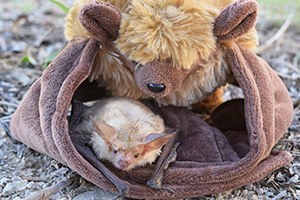Animal Fact Sheet: Cave myotis bat |
Identifying Features The Cave myotis (Myotis velifer) is a medium-sized bat with brown or black fur on its back and paler fur on its underside. Its ears are short and pointed and its eyes are small. |
 |
Migration/Hibernation During the summer these bats can be found roosting in caves in groups of 2,000-5,000 individuals. Some of these will stay and hibernate over winter, but most appear to be migratory over short distances. |
Habitat As indicated by their name the cave myotis prefers a cave habitat, but will choose other roosting areas if a suitable cave is not available. These alternate areas can include mines, rock crevices, abandoned buildings, barns and under bridges. |
Range These bats are found throughout the southwestern United States from central Oklahoma and Texas to New Mexico, Arizona and extreme southeast California. They also extend their range into Mexico and Central America. |
Wild Status The cave myotis is considered to be doing well and is listed as a species of least concern. |
Diet Cave myotis are insectivores. They feed upon a wide variety of insects depending upon which are available on any given night. They find their prey by using echolocation. This method of hunting helps them to determine the size and form of their prey as well as helps them avoid obstacles during flight. |
Predators Predators vary, but can include hawks, snakes, owls, raccoons, feral cats and coyote. |
Reproduction Mating occurs in late fall, but as with many other bat species the female will store the sperm until early spring. They give birth to a single pup in June or July. The young learn to fly at three weeks old. |
Life Span Their life span is approximately 10-15 years. |
Size Weight 0.4-0.5 oz (12-15 g). Wingspan 11-13 in (28-33cm) |
Extra Fun-facts
|










